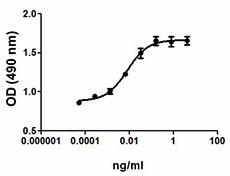- Regulatory Status
- RUO
- Other Names
- Colony stimulating factor 2 (CSF2), Granulocyte/macrophage colony-stimulating factor, CSF-α, Pluripoietin-α, Eosinophil colony stimulating factor (Eo-CSF), Burst promoting activity (BPA)

-

FDC-P1 cell proliferation induced by rat GM-CSF.
| Cat # | Size | Price | Quantity Check Availability | ||
|---|---|---|---|---|---|
| 592602 | 10 µg | $147.00 | |||
| 592604 | 25 µg | $253.00 | |||
| 592606 | 100 µg | $733.00 | |||
Select size of product is eligible for a 40% discount! Promotion valid until December 31, 2024. Exclusions apply. To view full promotion terms and conditions or to contact your local BioLegend representative to receive a quote, visit our webpage.
Csf2 is the gene that encodes GM-CSF (granulocyte-macrophage colony stimulating factor), which is conserved in human, chimpanzee, Rhesus monkey, dog, cow, mouse, and rat. GM-CSF plays a key role in signaling emergency hemopoiesis (predominantly myelopoiesis) in response to infection, including the production of granulocytes and macrophages in the bone marrow and their maintenance, survival, and functional activation at sites of injury or insult. The receptor for GM-CSF is a heterodimer that comprises a major binding subunit (GMRalpha) and a major signaling subunit (beta-c). The beta-c chain is a common subunit for GM-CSF, IL-3, and IL-5 receptors. The receptor subunits are always coexpressed on the surface of leukocytes, with beta-c being expressed at lower levels than GMRalpha. Certain nonhemopoietic cell types also express the GM-CSF receptor. GM-CSF has anti-apoptotic functions on neurons and is neuroprotective in animal stroke models. It stimulates neuronal differentiation of adult neuronal stem cells (NSCs). GM-CSF has been identified as a factor involved in arteriogenesis after brain ischemia. In addition, GM-CSF induces arteriogenic growth of collateral vessels after occlusion of cardiac or peripheral arteries.
Product Details
- Source
- Rat GM-CSF, amino acids (Ala18-Lys144) (Accession# NM_053852) was expressed in E. coli.
- Molecular Mass
- The 128 amino acid recombinant protein has a predicted molecular mass of approximately 14.6 kD. The DTT-reduced and non-reduced proteins migrate at approximately 17 and 14 kD respectively by SDS-PAGE. The N-terminal amino acid is Met.
- Purity
- >95%, as determined by Coomassie stained SDS-PAGE.
- Formulation
- 0.22 µm filtered protein solution is in PBS, pH 7.2
- Endotoxin Level
- Less than 0.01 ng per µg cytokine as determined by the LAL method.
- Concentration
- 10 and 25 µg sizes are bottled at 200 µg/mL. 100 µg size and larger sizes are lot-specific and bottled at the concentration indicated on the vial. To obtain lot-specific concentration and expiration, please enter the lot number in our Certificate of Analysis online tool.
- Storage & Handling
- Unopened vial can be stored between 2°C and 8°C for up to 2 weeks, at -20°C for up to six months, or at -70°C or colder until the expiration date. For maximum results, quick spin vial prior to opening. The protein can be aliquoted and stored at -20°C or colder. Stock solutions can also be prepared at 50 - 100 µg/mL in appropriate sterile buffer, carrier protein such as 0.2 - 1% BSA or HSA can be added when preparing the stock solution. Aliquots can be stored between 2°C and 8°C for up to one week and stored at -20°C or colder for up to 3 months. Avoid repeated freeze/thaw cycles.
- Activity
- ED50 = 5 - 20 pg/ml, corresponding to a specific activity of 5 - 20 x 107 units/mg, as determined by induction of FDC-P1 cell proliferation.
- Application
-
Bioassay
- Application Notes
-
BioLegend carrier-free recombinant proteins provided in liquid format are shipped on blue-ice. Our comparison testing data indicates that when handled and stored as recommended, the liquid format has equal or better stability and shelf-life compared to commercially available lyophilized proteins after reconstitution. Our liquid proteins are verified in-house to maintain activity after shipping on blue ice and are backed by our 100% satisfaction guarantee. If you have any concerns, contact us at tech@biolegend.com.
- Product Citations
-
Antigen Details
- Distribution
-
T cells, macrophages, fibroblasts, endothelial cells, mast cells.
- Function
- GM-CSF, in conjuction with IL-3 and IL-5, regulates the production and functional activation of hemopoietic cells. GM-CSF acts on monocyte/macrophages and all granulocytes. GM-CSF is critical for dendritic cell development and maturation. GM-CSF is induced by LPS, IL-1, IL-6 and TNF-α, and inhibited by IL-10, IFN-γ, IL-4, cyclosporine A, and glucocorticoids.
- Interaction
- Granulocyte/macrophage/erythroid/megakaryocytic progenitors, myeloblasts, monoblasts, dendritic cells, T cells, endothelial cells, alveolar epithelial cells, neuroepithelial cells, adult neuronal stem cells, cortical neurons.
- Ligand/Receptor
- Heterodimer GM-CSFR α subunit (CDw116) and β-subunit (CDw131).
- Cell Type
- Embryonic Stem Cells, Hematopoietic stem and progenitors
- Biology Area
- Immunology, Innate Immunity, Stem Cells
- Molecular Family
- Cytokines/Chemokines, Growth Factors
- Antigen References
-
1. Xing Z, et al. 1996. J. Clin. Invest 97:1102.
2. Schneeloch E, et al. 2004. PNAS 101:12730.
3. Hossmann KA and Buschmann IR. 2005. Expert Opin. Biol. Ther. 5:1547.
4. Shi Y, et al. 2006. Cell Res. 16:126.
5. Kruger C, et al. 2007. BMC Neurosci. 8:88.
6. Schabitz WR, et al. 2008. J. Cereb. Blood Flow Metab. 28:29.
7. Hercus TR, et al. 2009. Blood 114:1289. - Gene ID
- 116630 View all products for this Gene ID
- UniProt
- View information about GM-CSF on UniProt.org
